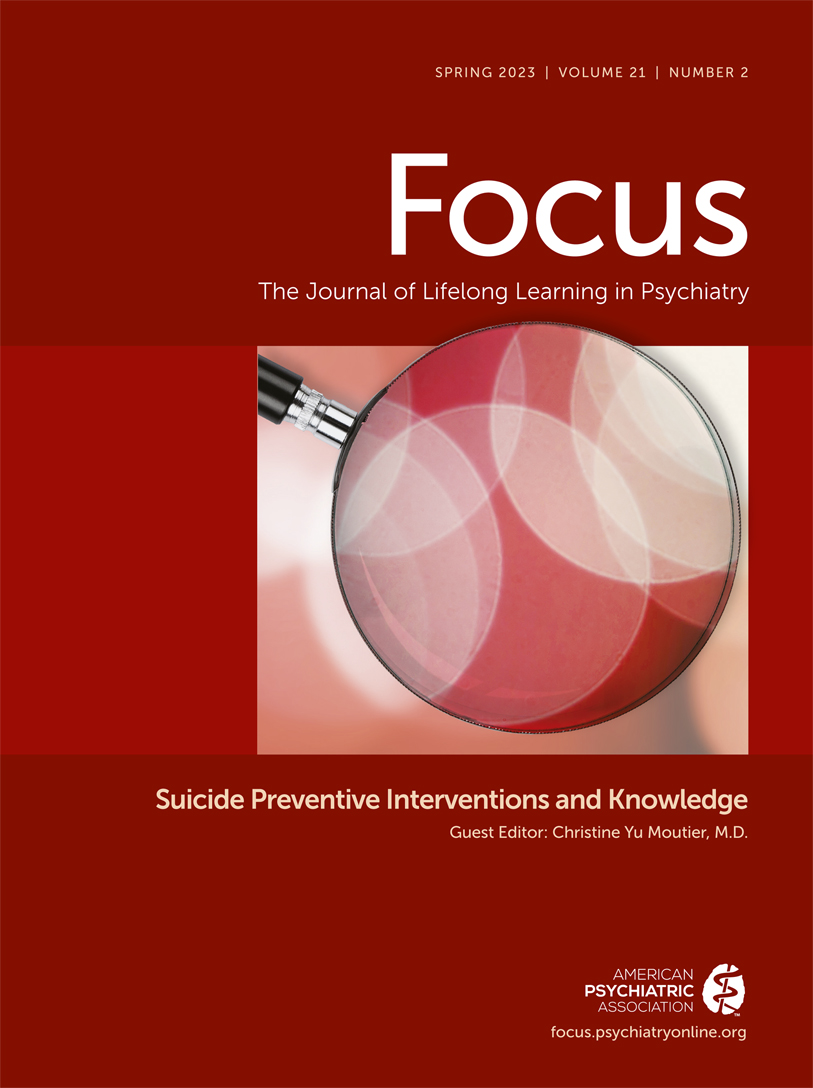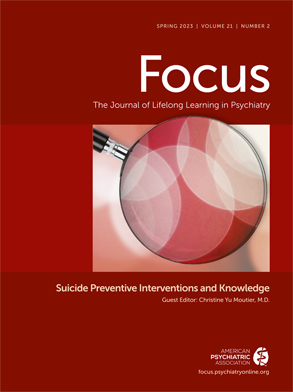Clinical Considerations for Digital Resources in Care for Patients With Suicidal Ideation
Abstract
Current Marketplace of Apps Targeting Suicidal Ideation and Behavior
| Suicide prevention approach | In-app feature examples | Recommendations for clinician and patient use | Limitations | Next-generation example |
|---|---|---|---|---|
| Connection to emergency resources (i.e., numbers for hotlines, emergency departments) | Crisis hotline number | Patients, clinicians, or caregivers should test emergency resources provided prior to an emergency scenario to ensure accuracy. | Some app-provided hotline numbers have been reported to be inaccurate or outdated. | Automatically provide a hotline number to an app user if baseline behavioral patterns established through ecological momentary assessments and smartphone sensors fluctuate |
| Psychoeducation | References allow patients or caregivers to learn more about their own diagnosis and potential treatment options. | Patients, clinicians, or caregivers should review in-app information to ensure accuracy and relevance to therapeutic goals established during office visits. | No established standardization or regulation to ensure in-app information is up to date, accurate, or derived from reputable sources | Personalized references provided to users based on symptom reports (collected through ecological momentary assessments) and behavioral patterns (collected through smartphone sensors) |
| Safety plan | Users can create digital safety plans on their device that include activities to alleviate stress and the person to contact in an emergency. | Clinicians or caregivers should check in with the patient’s use and opinion of a digital safety plan to enhance engagement and confirm relevancy. | Scientific evidence demonstrating that in-app safety plans mirror plans derived in clinic and improve patient outcomes is lacking. Clinicians and patients should be aware of privacy concerns and limited data security of some mental health apps prior to inputting personal information. | A safety plan created on a mobile device is synced with patient’s electronic medical record, allowing for real-time collaboration with the patient’s health care team. |
| Assessments (i.e., Patient Health Questionnaire–9 and Generalized Anxiety Disorder–7) | Real-time symptom assessments can allow patients and clinicians to monitor symptom severity on a more consistent basis. | Clinicians or caregivers should check in with the patient’s use of in-app assessments and integrate these screeners into the patient’s treatment plan. | Mental health apps have limited response if a patient describes worsening symptoms. Clinicians and patients should be aware of privacy concerns and limited data security of some mental health apps prior to inputting personal information. | Integration of in-app assessments with a patient’s electronic medical record can allow for real-time collaboration with the patient’s health care team. |
| Social and network support | Many apps mirror the social connections and online communities of social media apps but target a more specific population. This feature can foster peer connections between patients and others with similar lived experiences. | Clinicians should check in with patients on the current level of support in their lives. Clinicians can encourage patients to seek online community support if they feel that is a good fit. | Some mental health apps do not monitor peer chats or forums, which can lead to the posting of inaccurate and potentially harmful content. | Integration of artificial intelligence in community-based forums can allow for the detection and removal of harmful and stigmatizing content. |
| Mood tracking | Mood tracking can allow clinicians and patients to understand how the patient is feeling longitudinally and not just on the day of the appointment. | Clinicians or caregivers should check in with the patient’s use of mood tracking and integrate app-provided data into the patient’s treatment plan. | Mental health apps have limited response if a patient describes worsening mood. Clinicians and patients should be aware of privacy concerns prior to inputting personal information. | Mental health apps would be able to respond with personalized recommendations of in-app activities and link the patient to professional, community-based resources if the patient’s reported mood worsens. |
| Psychotherapies (i.e., cognitive-behavioral therapy [CBT] or dialectical behavior therapy [DBT]) | Additional activities can continue to promote therapeutic goals between office visits or at times when the clinician is not available. | Clinicians, caregivers, or patients should review content of the app to ensure that any activities are accurate and align with therapeutic goals established during office visits. | Mental health apps claiming to be based on evidence-based therapies (i.e., CBT and DBT) should not be conflated with the app having an evidence base itself. The current evidence base for mental health apps is sparse. There are no current standardization or regulations of the content in mental health apps. | The patient-facing mobile app is synced with a clinician-facing app, allowing the clinician or other member of the health care team to customize any therapeutic activities provided and align activities with the patient’s individual goals. |
| In-app counseling | In-app counseling provides patients additional synchronous telehealth visits in a format that is accessible. | Clinicians should encourage their patients to look at the credentials of counselors provided. | No established standard or regulation for the licensure or training of counselors provided | In-app counselors would have access to in-app assessments and behavioral patterns collected through smartphone sensors and make recommendations based on these data streams. |
Next Generation of Apps Targeting Suicidal Ideation and Behavior
Integration of Apps Into Clinical Care Today

Conclusions
Acknowledgments
References
Information & Authors
Information
Published In
History
Keywords
Authors
Competing Interests
Metrics & Citations
Metrics
Citations
Export Citations
If you have the appropriate software installed, you can download article citation data to the citation manager of your choice. Simply select your manager software from the list below and click Download.
For more information or tips please see 'Downloading to a citation manager' in the Help menu.
View Options
View options
PDF/EPUB
View PDF/EPUBLogin options
Already a subscriber? Access your subscription through your login credentials or your institution for full access to this article.
Personal login Institutional Login Open Athens loginNot a subscriber?
PsychiatryOnline subscription options offer access to the DSM-5-TR® library, books, journals, CME, and patient resources. This all-in-one virtual library provides psychiatrists and mental health professionals with key resources for diagnosis, treatment, research, and professional development.
Need more help? PsychiatryOnline Customer Service may be reached by emailing PsychiatryOnline@psych.org or by calling 800-368-5777 (in the U.S.) or 703-907-7322 (outside the U.S.).

